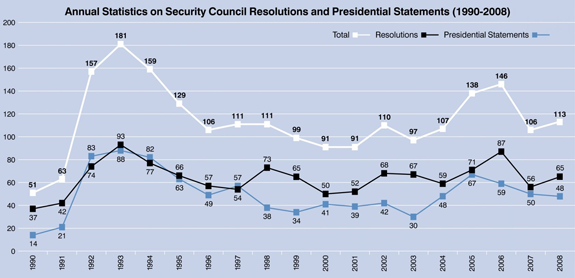Security Council Statistics for 2008
In 2008 the total number of Council decisions (resolutions and presidential statements) increased by seven from 2007, i.e. from 106 to 113. The increase in overall Council activity was much more significant. The number of formal meetings increased by 20 percent (from 202 to 243). There was no major change in the number of reports submitted to the Council by the Secretary-General. The number of press statements also remained at the same level as the year before.
Below is a chart that shows annual Council output as measured by resolutions and presidential statements since 1990. (SCR first published Council statistics in our March 2007 Forecast. Please refer to our website for an analysis of 2006 and 2007 Council output.)

There were significant changes in Council output at the country-specific and thematic levels in 2008, reflecting new developments. The number of decisions on Somalia doubled compared with 2007 as the situation in that country continued to worsen. A new development in the Council was the focus on anti-piracy measures following the surge in piracy off the coast of Somalia. Another important development was the consensus on strengthening the Somalia sanctions regime.
There were five meetings on the situation in Zimbabwe, but the only outcome was a presidential statement. A proposed resolution was vetoed by China and Russia.
There was a significant increase in the number of meetings on Sudan (from 14 to 23). This reflected ongoing concerns about the situation in Sudan but also, in particular, problems with the deployment of the UN-AU Hybrid Operation in Darfur (UNAMID).
Myanmar continued to be discussed by the Council at about the same level in 2008 as in 2007.
There was a notable increase in decisions on thematic issues. The number of thematic resolutions increased by more than 50 percent compared to 2007 (from five to 12). The 2008 total is therefore closer to that in 2006 when the Council adopted 15 thematic resolutions. There was a new resolution on women, peace and security (sexual violence) and on UN cooperation with regional organisations.
Some of the increase in 2008 can be explained by a doubling of decisions on the International Criminal Tribunals for the former Yugoslavia and Rwanda due to technical issues (extension of terms of judges).
The Council also adopted resolutions for the three counter-terrorism committees of the Security Council, extending the mandates of the Counter-Terrorism Executive Directorate (for two years), the Analytical Support and Sanctions Monitoring Team (for 18 months) and the 1540 Committee on weapons of mass destruction and terrorism (for three years). Since these mandates are renewed at different intervals, the number of resolutions will inevitably vary from one year to the next. In 2007 there was only one resolution on counter-terrorism.
There was a marked drop in the number of decisions related to the Middle East, from 15 in 2007 to ten in 2008. On Israel-Palestine, the number of meetings remained the same (a majority being monthly briefings), but the Council remained deeply divided and was unable to respond to specific crises on the ground. However, an important development was the resolution adopted on 16 December in support of the peace process—in effect the adoption 12 months late of a resolution originally envisaged after the conclusion of the Annapolis summit meeting. Another important feature in 2008 was the marked reduction of Council focus on Lebanon. The political crisis was left to players outside the UN and the Council mainly focused on briefings and mandate renewals.
There was a fairly substantial rise in the number of formal Council meetings with no corresponding increase in output. The crisis in Georgia in August is an example. It led to a flurry of dramatic meetings but no outcomes. Zimbabwe, referred to above, was another example.

